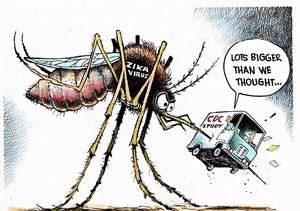Threat of Zika Virus Still Significant in California

Since 2015, California has seen many travel-related Zika virus cases, and as the population of mosquitos that spread the virus continue to expand across the state, there is a significant risk for new Zika cases, according to results published in Emerging Infectious Diseases.
The Zika outbreak was first reported in Brazil in 2015, and numerous travel-related cases have since been reported in the United States.
This study included reported cases of travel-associated Zika cases California from November 2015 to September 2017 (N=588), including 139 infections in pregnant women, 10 congenital infections, and 8 sexually transmitted infections. The researchers recorded data on sex, age, race/ethnicity, country where exposure likely took place, duration of travel, symptoms, symptom onset date, pregnancy status, and outcomes. For all cases where patients had a travel duration of <6 months, the researchers compared the duration of time in Zika-infected areas between pregnant patients and all other patients using the Kruskal-Wallis test for 2 groups to retrospectively assess time at risk.
A total of 570 patients contracted Zika while traveling outside of California. The most common destinations were Mexico (36.4%), Central America (34.3%), or the Caribbean (13.1%). The 10 most common countries and territories where patients traveled were Mexico (36.4%), Nicaragua (9.6%), Guatemala (8.4%), El Salvador (7.0%), Dominican Republic (4.4%), Puerto Rico (4.4%), Honduras (3.9%), Costa Rica (3.7%), Jamaica (2.5%), and Colombia (1.8%).
Of the 570 participants who traveled outside of California, 13.9% (n=79) were in their country of exposure for ≥6 months. Among patients who were in the country of exposure for <6 months, women who were pregnant at time of diagnosis had a significantly longer travel duration (median 14 days [range 1-153 days]) compared with all other Zika case-patients (median 11 days [range 1-137 days]; P=.03).
A total of 466 patients presented with symptoms. The most common symptom was rash (89.0%; n=415), followed by arthralgia (62.5%; n=291), fever (60.1%; n=280), myalgias (36.9%; n=172), and conjunctivitis (35.0%; n=161). Of note, a rash without any other symptom was reported by 10.5% (n=49) case-patients.
Among 139 women who were pregnant at the time of Zika diagnosis, 120 had completed their pregnancies by September 1, 2017. Of these, 114 women had live births, and 6 experienced fetal losses. Out of the 120 live births, 90 of the infants were tested for Zika at or shortly after birth, 73.7% (n=84) had negative results for Zika virus, and 5.3% (n=6) had positive results.
During the study period, 8 infants were born with Zika-associated birth defects, 2 of whom tested negative for Zika and 6 of whom tested positive.
By September 2017, Aedes aegypti mosquitoes were found in 124 locations in California, and Aedes albopictus mosquitoes were found in 53 locations. The rise in the number of locations where these mosquitos are found presents a continuing risk for Zika transmission within California.
"There is still a risk for pregnant women and all those who travel to these countries, and it is necessary that prevention messaging remains targeted and operative," the researchers wrote. "Healthcare providers should continue to be suspicious of returning travelers with rash, fever, conjunctivitis, or arthralgia, particularly when other diagnoses have been ruled out."
